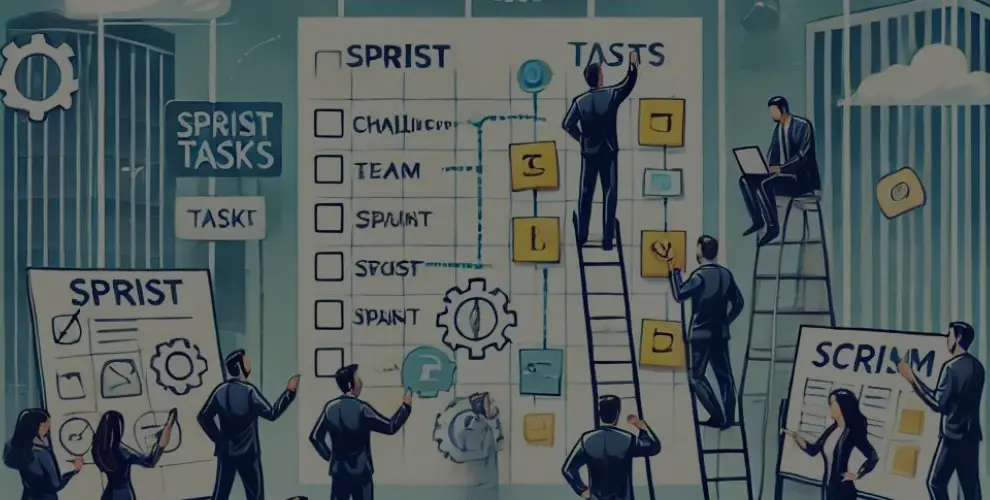
Avoid the Pitfalls: Scrum Challenges and How to Overcome Them
Table of Contents
Introduction
Welcome to WikiGlitz, where we bring you this amazing blog on Scrum challenges and how to overcome them.
Whether you’re a Scrum Master, developer, or project manager, you’ve likely encountered obstacles while implementing Scrum.
While Scrum is one of the most popular Agile frameworks, its success heavily depends on proper execution and team collaboration.
However, even the most well-intentioned Scrum practices can encounter hurdles, leading to frustration and inefficiency.
In this article, we’ll explore the common Scrum pitfalls faced by teams, understand why they happen, and discuss practical ways to overcome them. Let’s dive into how to solve Scrum problems and ensure your team operates more efficiently.
Key Takeaways
- Identify and address common Scrum pitfalls before they become major blockers to project success.
- Foster open communication and regular collaboration within the team to avoid Scrum team issues.
- Continuous Scrum process improvement through retrospectives and adjustments is crucial for optimal performance.
What are the common challenges in Scrum?
Scrum, though highly effective, comes with its own set of challenges. Some of the common Scrum pitfalls include:
- Miscommunication: Teams sometimes struggle with clear communication during sprints, which leads to misunderstandings about tasks and project goals.
- Role confusion: Misunderstanding the roles of Product Owner, Scrum Master, and Development Team is a frequent issue. It can result in bottlenecks and slow progress.
- Sprint goals not being met: Poor planning and lack of flexibility during sprint execution often prevent teams from achieving their goals.
These Scrum implementation problems can derail even the best-laid plans. Teams that don’t address them promptly often struggle with poor performance and unachieved targets.
How to deal with Scrum challenges effectively?
To overcome Scrum challenges, teams need to be proactive and deliberate. Here are some effective strategies:
- Enhance communication: Schedule regular check-ins to ensure everyone understands their tasks. Scrum Masters should facilitate daily stand-ups and retrospectives.
- Clarify roles: Ensure each team member understands their role and how it contributes to the sprint’s success. For example, the Scrum Master must focus on eliminating obstacles, while the Product Owner sets clear priorities.
- Improve sprint planning: Break down tasks into manageable chunks and maintain flexibility to adapt to changes in requirements. The team should be open to adjusting the sprint backlog when necessary.
By focusing on these actions, teams can effectively resolve Scrum team issues and enhance overall performance.
What are the disadvantages of Scrum, and why does it fail?
Scrum’s success depends on its proper implementation, and there are certain disadvantages that can lead to its failure:
- Rigid adherence to Scrum rules: While the Scrum framework provides structure, some teams become too rigid and fail to adapt to specific project needs. This can lead to Scrum framework issues.
- Overload on the Scrum Master: The Scrum Master’s responsibilities can sometimes become overwhelming, especially when managing large teams. This may lead to inefficiencies and Scrum Master challenges.
- Poorly defined product backlog: If the product backlog isn’t well-organized or prioritized, the team may lose focus, causing sprints to fail.
These factors can contribute to why Scrum fails. However, recognizing and addressing them can help teams avoid such outcomes and ensure smoother project flow.
What are the Scrum Master roles and responsibilities in solving Scrum problems?
The Scrum Master plays a vital role in resolving Scrum challenges. They are responsible for ensuring that the Scrum framework is followed while helping the team perform at its best. Here are some key Scrum Master roles and responsibilities related to solving Scrum problems:
- Facilitating communication: A Scrum Master ensures that the team stays connected and works collaboratively. Regular check-ins and retrospectives help in addressing team collaboration issues before they escalate.
- Removing roadblocks: The Scrum Master helps eliminate any obstacles that hinder progress. Whether it’s a technical issue or a team conflict, they are responsible for ensuring the team stays focused on their sprint goals.
- Coaching and mentoring: As part of their role, Scrum Masters coach teams on how to best utilize Scrum practices, ensuring that they continuously improve their approach.
By guiding the team and facilitating smooth execution, the Scrum Master helps solve Scrum problems and solutions while driving overall project success.
How to improve Scrum practices and fix broken Scrum processes?
Fixing broken Scrum practices is essential for maintaining team productivity and efficiency. Here are a few ways to improve Scrum practices and resolve common Scrum process improvement issues:
- Conduct thorough retrospectives: Retrospectives provide a platform for the team to reflect on what went wrong during the sprint.
- Revise sprint goals: Sometimes, sprints fail because goals are unrealistic or poorly defined. Regularly revising sprint goals and ensuring they are achievable can make a big difference.
- Improve task breakdown: Breaking down tasks into smaller, more manageable pieces can help prevent the team from feeling overwhelmed. This also ensures that progress can be tracked more effectively.
Fixing broken Scrum practices requires a proactive approach, regular feedback, and an openness to change. By focusing on continuous improvement, teams can avoid Scrum pitfalls and overcome Scrum challenges.
How do team collaboration issues impact Scrum, and how can they be resolved?
Team collaboration issues in Scrum are one of the most common reasons for project delays and failures. When team members don’t collaborate effectively, tasks can overlap, work may be duplicated, or critical tasks may be neglected. Here’s how you can address these issues:
- Encourage open communication: Regular team discussions and daily stand-ups are essential for keeping everyone aligned. Team members should feel comfortable discussing their challenges and asking for help when needed.
- Cross-functional teamwork: Ensure that team members are cross-trained in different roles, which encourages flexibility and collaboration. This helps reduce dependency on individual contributors and promotes team cohesion.
- Use collaboration tools: Tools like Slack, Jira, and Trello can help teams stay organized and ensure that everyone knows the current sprint status.
By improving collaboration, teams can effectively mitigate Scrum problems and keep the project on track.
How to avoid Scrum pitfalls and ensure successful Scrum implementation?
Avoiding Scrum pitfalls is crucial for successful project execution. Here’s how teams can prevent common mistakes during Scrum implementation:
- Set clear sprint goals: One of the major Scrum pitfalls is having ambiguous or unattainable sprint goals. The Product Owner must ensure that sprint objectives are clearly defined and aligned with the team’s capacity.
- Foster team accountability: Hold each team member accountable for their tasks. A lack of ownership can lead to incomplete or poorly executed work.
- Prioritize flexibility: While Scrum has a structured framework, successful teams stay flexible. If something isn’t working, such as the current sprint backlog or team dynamics, adjustments should be made promptly.
By identifying and addressing these issues early on, teams can avoid Scrum implementation problems and stay on track for project success.
How can Scrum frameworks be adjusted to solve Scrum challenges in agile teams?
Scrum frameworks are not one-size-fits-all; they may need adjustments to fit the specific needs of a team or project. Here’s how teams can tweak their Scrum frameworks to address Scrum challenges:
- Adapt the sprint length: Teams facing constant pressure to meet sprint goals may benefit from adjusting the length of their sprints. Shorter sprints might not give enough time to complete complex tasks, whereas longer ones may allow for more thorough planning and execution.
- Tailor roles and responsibilities: If team members are struggling to meet their responsibilities, it may help to reevaluate and redistribute roles to better align with individual strengths.
- Experiment with hybrid models: Some teams benefit from combining Scrum with other methodologies, such as Kanban, to improve flexibility and efficiency. This approach can help solve Scrum framework issues.
Customizing the Scrum framework to fit the unique needs of a team can prevent Scrum challenges from derailing the project and improve overall productivity.
Why are Scrum challenges more prominent in Agile teams, and how can they be mitigated?
Scrum challenges can be more prominent in Agile teams, especially when transitioning from traditional project management methods. Here’s why these challenges arise and how to mitigate them:
- Lack of Agile mindset: Teams accustomed to hierarchical structures may struggle with the self-organizing nature of Agile. Encouraging an Agile mindset through training and team-building activities can ease this transition.
- Resistance to change: Team members may resist the iterative process of Scrum, preferring longer planning cycles. Overcoming this resistance requires strong leadership and consistent communication about the benefits of Agile.
- Inconsistent team engagement: Agile teams rely heavily on each member’s engagement. If some members are disengaged or unaware of their roles, the team’s progress will be hindered. Ensuring that all team members are fully committed to the Agile process is key to success.
By addressing these specific Scrum challenges in Agile teams, organizations can minimize disruption and improve team performance.
Conclusion
Welcome to the end of our journey through Scrum challenges here at WikiGlitz!
Successfully implementing Scrum requires awareness of common pitfalls and proactive strategies to overcome them.
From improving communication within the team to refining Scrum practices, the key to success lies in continuous learning and adaptation.
As we’ve explored, issues such as team collaboration problems, poor sprint planning, and Scrum framework issues can undermine your project’s progress.
However, with the right approaches—like clear role definitions, regular retrospectives, and a flexible mindset—these hurdles can be effectively addressed.
At WikiGlitz, we are dedicated to providing insightful content that helps you navigate the complexities of Agile and Scrum.
Be sure to follow WikiGlitz for more such insights on improving your software development practices and staying ahead in the ever-evolving world of technology!
FAQs
What are the biggest hurdles to overcome in Scrum implementation?
Some of the largest hurdles include unclear sprint goals, miscommunication, and lack of role clarity. Addressing these early can help prevent Scrum challenges from becoming larger issues.
How can Scrum Masters foster better team collaboration?
Scrum Masters can enhance team collaboration by facilitating daily stand-ups, retrospectives, and encouraging open communication. They play a critical role in solving team collaboration issues in Scrum.
What are the key warning signs of broken Scrum practices?
Signs include failing to meet sprint goals regularly, low team morale, and frequent miscommunication. These are indicators that your team may need to focus on Scrum process improvement.
How can you prevent Scrum from failing in your organization?
To prevent failure, ensure that the Scrum framework is adapted to your team’s needs, sprint goals are achievable, and regular feedback loops are in place. Address Scrum Master challenges and continuously improve your processes.
What are the most important ways to improve Scrum efficiency?
To improve efficiency, focus on refining sprint planning, enhancing communication, and making your backlog more manageable. Continuous adaptation is key to Scrum process improvement and success.
Want to keep up with our blog?
Our most valuable tips right inside your inbox, once per month.
Error: Contact form not found.
WikiGlitz Team
Welcome to WikiGlitz, your ultimate destination for tech insights and innovation. Our expert team is dedicated to delivering free resources and professional advice on various technology topics, including Artificial Intelligence, Cyber Security, Cloud Computing, and more. We strive to empower our readers with up-to-date information and practical guidance, ensuring you stay ahead in the rapidly evolving tech landscape. At WikiGlitz, we are passionate about making complex technology accessible to everyone. Our team of seasoned experts curates content that is both informative and engaging, helping you understand and leverage the latest tech trends. Whether you're a tech enthusiast or a professional, WikiGlitz is your go-to source for reliable, expert-driven content. Join us on this journey to explore and embrace the future of technology.





